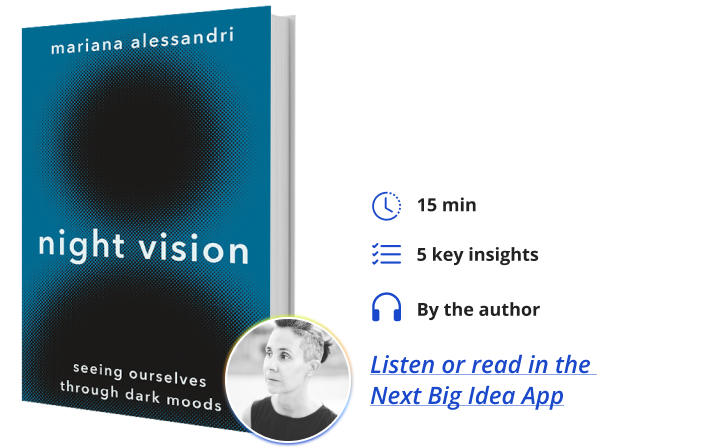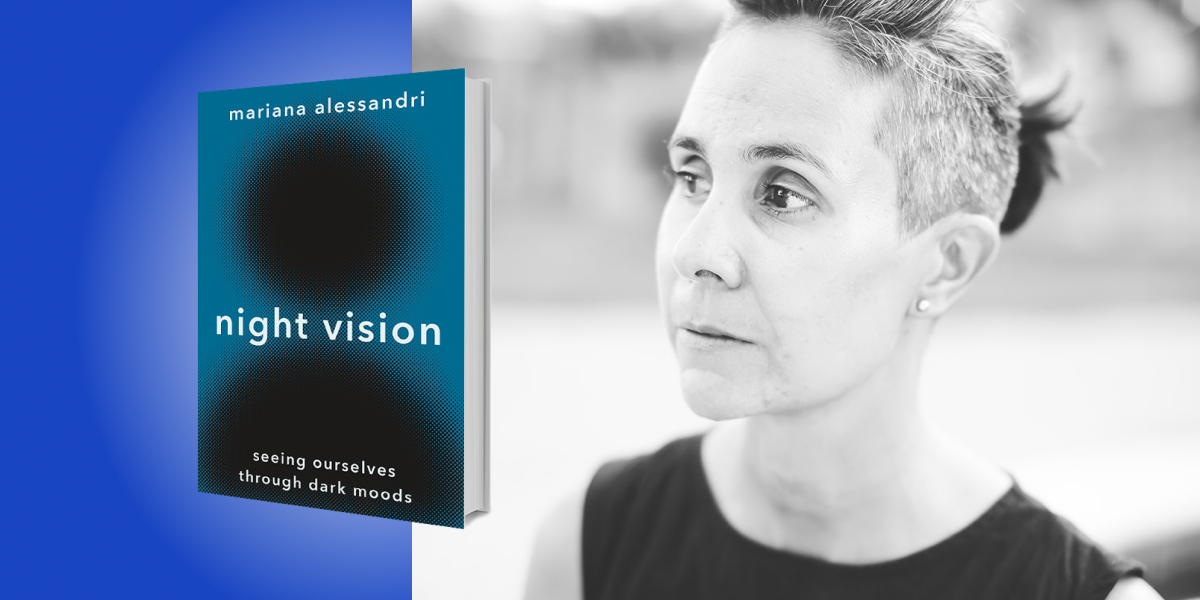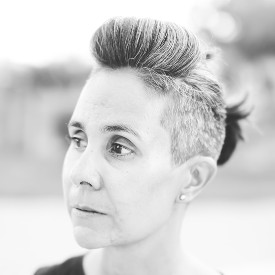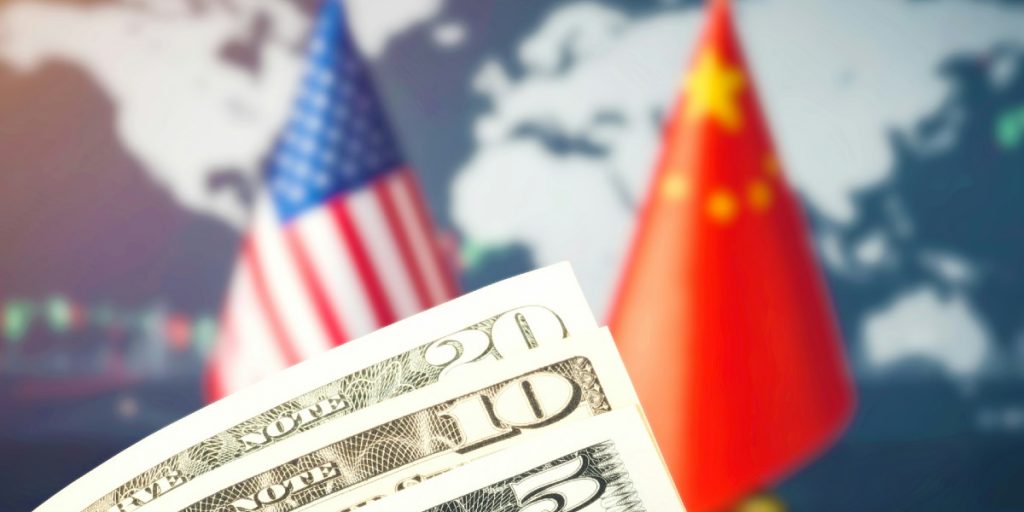Mariana Alessandri teaches philosophy at the University of Texas Rio Grande Valley. Below, she shares 5 key insights from her new book, Night Vision: Seeing Ourselves Through Dark Moods. Listen to the audio version—read by Mariana herself—in the Next Big Idea App.

1. Let’s not default to “anger is irrational.”
We live in a culture so obsessed with love and light that we’ve become intolerant of dark moods. There’s a poster at my airport that says: “It will get brighter” and shows a light at the end of the tunnel. A woman at the gate is wearing a t-shirt that says, “Stay positive.” My son’s soccer coach wears one that says #nobaddays. This is the imposition of what I call the Light Metaphor: all the little suggestions that light is better than dark, happiness hipper than sadness, tranquility trendier than anger, and optimism holier than pessimism.
I’m not surprised that we’re pressured into staying sunny, but it’s making us feel bad about feeling bad. The underbelly of the Light Metaphor is the Brokenness Story, and it gets activated every time we fail to make our own sunshine. We who live with anger, sadness, grief, depression, and anxiety often feel like we’re the oddballs of society; like everyone else is Tigger and we’re grumpy little Eeyore. As an existentialist, though, I believe to my bones that to be human is to live with darkness. We hurt, we bleed, we die.
The Ancient Greek and Roman Stoics said we shouldn’t let ourselves feel anger. Have you ever apologized for getting angry? That’s Stoic. Aristotle said it’s ok to get angry so long as we don’t act on it, so if you’ve ever apologized for yelling, that’s more Aristotelian. In the light of ancient philosophy, anger is something to control, suppress, or diffuse, if it can’t be prevented. In the dark, anger looks different. Audre Lorde said that all women have an arsenal of anger that’s just waiting to be tapped into. She says we can use anger to “excavate honesty,” to get to the heart of injustice instead of assuming there is something wrong with getting angry. If we diffuse our anger on a punching bag, Lorde might think that’s a waste of a perfectly dark mood. In the light, anger looks poisonous. The answer? Get rid of it. In the dark, anger looks like information. The answer? Listen to it.
2. If bodies are united by pleasure, souls are united by pain.
I see little boys on my son’s baseball team being told not to cry. Why? The Epicureans believed that a happy life consisted of maximizing pleasure and minimizing pain. They wanted us to feel as little emotional pain as possible. I use the Spanish word dolor to describe sorrow because it captures many types of pain in one. In the light of Epicureanism and Positive Psychology, dolor looks unhealthy and shameful—criticized as a pity party or wallowing.
“He believed that people connect better when they are sad, because happy people are often worried that someone will bring them down.”
The Spanish philosopher Miguel de Unamuno helps me see dolor in the dark. His life was very dark. He lost a child and suffered a lot more after that. But he was constantly defending himself against people who said suffering should happen in private. Dolor, he noticed, can draw people closer. He believed that people connect better when they are sad, because happy people are often worried that someone will bring them down. He also thought that suffering recognizes suffering. Stephen Colbert said something similar to Anderson Cooper in an interview about death. Colbert was talking about losing his father and brothers as a young child, and he said that the experience made him more able to recognize suffering, even when someone’s trying to hide it.
In the light, dolor looks self-indulgent. In the dark, dolor looks like an opening for true connection.
3. Society mishandles grief.
When you grieve the death of a loved one, you make people squirm. This explains why grievers hide their pain.
Cicero said grief is optional because he witnessed a soldier on the battlefield not cry after losing a child. He said you shouldn’t indulge your grief because it’s weak and womanish. You should get over the death of loved ones as quickly as possible, with the help of busyness and distraction in the way of poetry and philosophy. In a light like this, grief makes a person look broken. Since 2010, there have been trials for grief medication. It’s looking more and more like a mental illness.
But there is a lot of opposition to the idea that grief is sick. There are lots of people who sit in the darkness of grief and defend it. The British writer C.S. Lewis was one; he wrote a whole book on how the death of his wife shattered his faith. He was ashamed of his grief, but he wrote the book anyway.
In the light, grief looks like something we need to get over. In the dark, grief looks like love. Megan Devine is a grief expert who lost her partner, and she says: “Grief isn’t a problem to be solved, it’s an experience to be tended.”
4. Depression is more than illness.
How do we talk about depression? It’s a mental illness suffered by twice as many women than men. People often feel ashamed of a depression diagnosis and don’t like to talk about it. That means that those who suffer from depression likely also suffer from shame.
In the light, depression used to look sinful—like laziness. In some cultures, it’s still seen as a personal weakness. In mainstream US culture, it’s gone from weakness to illness, like alcoholism. Psychiatrists like Peter Kramer have a zero-tolerance policy on depression, and they write books saying that our goal should be to eradicate it completely.
“Are there more helpful words to use for depression besides mental illness?”
Gloria Anzaldúa was a Chicana philosopher from Deep South Texas, sixth generation Mexican American. She didn’t use “brain disease” talk. Instead, she used the Aztec goddess Coatlicue to describe her dark mood. The weeks she spent in a depressive episode, when she stopped washing dishes and stopped seeing people, and mostly slept and read in the dark—she called it being in the stony arms of Coatlicue, a mother goddess with snakes for heads. Anzaldúa hated it, but didn’t want to call herself broken. Toward the end of her life, Anzaldúa described her depression as one stage in a seven-stage process she called conocimiento. Conocimiento is a deep kind of knowing that usually begins with an existential earthquake and ends with personal and social transformation.
The idea isn’t to get people to start calling depression “The Coatlicue State” but to interrogate the metaphors we use. Are there more helpful words to use for depression besides mental illness? Is there a way to feel less bad by using better language?
In the light, depression is a sign that you’re broken. In the dark, depression is a sign that you are, in Anzaldúa’s words, “excruciatingly alive to the world.”
5. Anxiety is the price of freedom.
Anxiety has long been called a neurosis, a disorder, or an illness. Since 2009, it’s the number one mental illness in America, especially among college students.
In Ancient Greece and Rome, anxiety was considered a case of bad reasoning. Cognitive Behavioral Therapy is based on the ideas of the Greek Stoic Epictetus, who said, “What upsets people is not things themselves but their judgments about these things.” At the same time, anxiety has always also been considered a medical problem, dating back to Ancient Greece. Cicero called philosophers “doctors of the soul.” Today we have therapists and psychiatrists. Who you go to for help shapes how you think of anxiety.
I don’t think we need to stop seeing therapists or psychiatrists, but I call upon Søren Kierkegaard to help me see anxiety in the dark. He was extremely anxious, so much so that he called off his wedding engagement to a woman he never got over. He didn’t want to condemn her to a life filled with his anxiety and depression, so he let her go.
“Anxiety is an intelligent reaction to a world filled with violence and war and poverty, and in which we’re mostly impotent.”
Despite all of it, Kierkegaard believed that anxiety makes us human. It’s not reason, like Aristotle thought, or storytelling, or art. Kierkegaard thought anxiety makes us superior to animals and angels. The more anxious you are, the more human; the more anxious a civilization, the more profound. Anxiety is an intelligent reaction to a world filled with violence and war and poverty, and in which we’re mostly impotent.
For some, anxiety is debilitating. Medication helps. There was a book published in the 1980s called Plato not Prozac. My book, Night Vision is more like Plato and Prozac. No medication can cancel anxiety—nor should it—but we can turn down the volume. Once it’s at a manageable level, Kierkegaard would advise us to listen to our anxiety, just like Lorde said to listen to our anger. Anxiety is trying to say something big, and a lot of existentialist philosophy is devoted to the idea that we are terrified of big things: death, nothingness, choice, freedom. We’ll scrub toilets if it means avoiding an existential crisis. But darkness is part of life and it’s part of us, and if we trash it, we trash ourselves.
In the light, anxiety is a sign that you’re irrational or sick. In the dark, anxiety is a sign that you are emotionally intelligent. The mission of Night Vision is to put dark moods under a dimmer light, where we won’t show up looking broken. Just human.
To listen to the audio version read by author Mariana Alessandri, download the Next Big Idea App today:






























